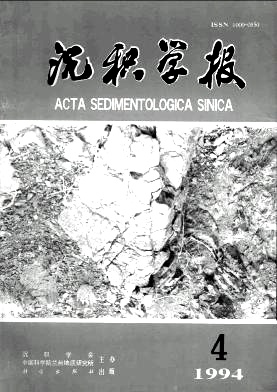Fu Bihong, Chou Xiaowei. Study of Thermal Infrared Spectra Features of Typical Sedimentary.Rocks from Kalpin Uplift in Tarim Basin[J]. Acta Sedimentologica Sinica, 1994, 12(4): 95-100.
| Citation:
|
Fu Bihong, Chou Xiaowei. Study of Thermal Infrared Spectra Features of Typical Sedimentary.Rocks from Kalpin Uplift in Tarim Basin[J]. Acta Sedimentologica Sinica, 1994, 12(4): 95-100.
|
Study of Thermal Infrared Spectra Features of Typical Sedimentary.Rocks from Kalpin Uplift in Tarim Basin
- Received Date: 1994-02-10
- Publish Date:
1994-12-10
-
Abstract
The research results of laboratory thermal infrared emissivity spectra of some typical clastic rocks, argillacous rocks, carbonate rocks and evaporite collected from ICalpin Uplift in Tarim Basin,integrated with the results of chemical anelysis, X-ray diffraction and thin section identification of rocks indcate that clastic rocks and argillaceous rocks with quartz have restrahlen band between 8 and l0μm,which results from interatomic stretching vibrations of silicon and oxygen bound in the crystal lattice. The band center has been shown to move to longer wavelengths and decrease in intensity with decreasing quartz content,Carbonate rocks exhibit low emissivity band at 11. 3μm due to C-O bending modes, the band center shown to move to shorter wavelengths with increasing Mg2+ content, and gypsum has an intense low emissity band near 8. 56μm caused by fundmental stretching motions of sulfate ion.The rock type, mineralogical composition and content of sedimentary rocks can be determined according to these features. The analyses of thermal infrared spectra features of sedimentary rocks provide a theoretical basis for thermal infrared multispectral remote sensing. According to the center wavelengths of restrahlen band (or low emissivity band)of sedimentary rocks, the relevant bands can be selected for airborne and spaceborne thermal infrared multispectral scanners(TIMS)to extract and distinguish the lithologic and mineralogic information. For example, 8. 13μm,9. 17μm,11. 3μm and 8. 56μm,etc. are the best band center for TIMS scanner. The TIMS will become a powerful new geologic remote sensing tool that can provide rich lithologic and mineralogic information in the future.
-
References
|
[1]
|
Abrams,M. J.,Abbott,E.,and Kahle, A.,1991.Combined use of visible, reflected infrared and thermal infrared images for mapping Hawaiian lava flows,J.Geophys.Res.96(B,);475~484. |
|
[2]
|
Gillespie ,.R.,Kahle. A. B.,and Palluooni, F. D.,1984, Mapping alluvial fans in Death Valley, California using multichannel thermal infrared images, Geophys. Res. Lett. 11(11):1153~1156. |
|
[3]
|
Gillespie,A. R.,Kah1e,A. B.,and Walker,R. E.,1986 ,Color enhancement of highly }rrelated images. I. decorrelation and HSI conVast stretches,Remote Sens. Environ.,20;209~235. |
|
[4]
|
Hunt, G. R.,and Salisbury, J. W.. 1975, Mid一infrared spectral behavior of sedimentary rocks, Air Force Cambridge Research Laboratories Technical Report TR一750356,49pp. |
|
[5]
|
Kahle, A, B, and Goetz. A. F. H,,1983, Mineralogic information from a new airborne thermal infrared multispeetral scanner,Science, 22;24~27. |
|
[6]
|
Lyon R. J. P.,1965, Analysls of rocks by speetral infrared emission (8 to 25 mierons),Econ. Gaol. 60:715~106. |
|
[7]
|
Salisbury, J. VV. and Daria, D. M.,1992, Emissivity of terrestrials materials in the 8~14um atmaepherlo window,Remote Sens. Environ.,42;83~106. |
|
[8]
|
Vincent, R. K.,Rowan , L. C.,Gillespie, R. E.,and Knapp. C.,1975. Thermal一infrared speetra and chemical analyses of twenty-six igneous rock samples ,Remote Sens. Environ.,4,199--209. |
|
[9]
|
Watson , K.,Kruse, F.,and Hummer, S.,1990, Thermal infrared exploration in the Carlin Trend, Geophysics, 55(1):70~79. |
-
-
Proportional views

-






 DownLoad:
DownLoad: